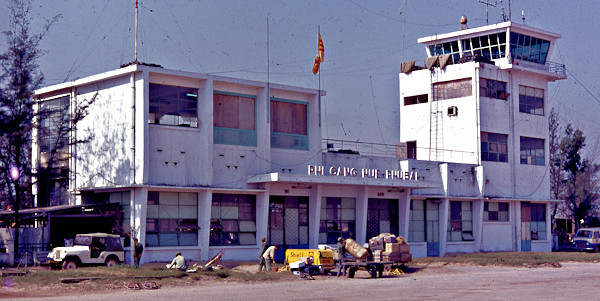
About |
M
A
T
C
U
by Michael T. Martin
 Terminal and Control Tower at Phu Bai |
|---|
|
I arrived in Vietnam during the Vietnam war sometime in November, 1968, not long after completing the Air Traffic Control Radar school in Glynco, Georgia. I reported to the Marine Air Traffic Control Unit (MATCU) 68 that operated the airport just outside the Imperial capital of Hue in Phu Bai. The airport served both Marine helicopter units and an Army unit of reconnaisance planes, as well as Vietnamese commercial airliners. The first night I served alone on duty, I aligned the Ground Control Approach (GCA) radar unit as I had been taught. This radar was used to land aircraft in bad weather when pilots could not see the ground. I alone stood responsible for fixing and aligning their GCA radar system. I had finished second in my training class, so I felt confident in my ability. Besides, when I arrived I found multiple pull-out boards of a tricky circuit that my predecessors had previously replaced instead of fixed, which I was able to align. During training, that circuit just clicked in my brain and I understood how it worked while many others found it baffling. It was the critical circuit that defined the linear or nonlinear characteristic of the glidepath slope that was drawn as an electronic line on the radar screen. Still, on that first official rainy night alone on duty I waited apprehensively inside with the radar operators. The radar system scanned two antennae, one vertically and one horizontally, to detect radar returns in both elevation and azimuth. The radar returns appeared as white blips on two dark radar displays and the operator would instruct pilots blinded by foul weather to alter their course so that their blip coincided with the white electronic line that I had the radar produce on the displays. When the pilot followed the instructions of the radar operator, the aircraft would descend on a three-degree glidepath right to the end of the runway. The requirement was that the weather provide only one-quarter mile of visibility so that the pilot would break out of the clouds with the runway right in front of him. Assuming that I had oriented the radar correctly and aligned that circuit to produce the correct glidepath on the radar screens, a happy ending would ensue. That first night, in a heavy overcast with moderate rain, the operator responded to a C-130 transport plane that needed to land with 50 Marines on board. A C-130 is a relatively large aircraft with four turboprops on an overhead wing. The squat tubular body with a towering tail at the end could carry tanks and other material, as well as troops. I had ridden on them, sometimes strapped on the floor in the cargo bay, once in the jump seat behind the pilots. Its name was the Hercules, but Marines called it the Herky Bird. It served as the workhorse transport in the Vietnam war. The radar operator began instructing the weather blinded pilot in accordance with the blips and lines on the radar screen. I went outside in the rain and walked toward the end of the runway, watching the darkness. Landing a plane in a rain was precisely the circumstance I had been trained, and the radar had been built, for. But as a fallible human being this was the first time something I did really mattered. There were over 50 people on a Herky Bird in the sky relying on my training and performance to land them at a hundred-fifty miles per hour in a driving rain at night with only a quarter-mile visibility. Ground lights along the runway's length indicated to me where the aircraft should appear. I anxiously watched beyond the end of the runway, ignoring the rain. Lights suddenly appeared in the sky falling toward the runway. The Herky Bird with 50 troops roared down the runway past me, loudly reversing its propellers to provide braking. It rolled to a normal landing and turned off the runway onto the tarmac. I went into the radome that covered the radar antennae. Everything had worked as I had been taught. I felt relieved that it had. Glad that it had. Several weeks later, in my official F.A.A. certification, an Air Force jet measured the accuracy of the glidepath I had aligned. The jet flew multiple horizontal paths using its instruments. The GCA operator told them when it crossed the glidepath I had created. We had two radar units, one was mostly a backup but it was tested also. When they tested the primary unit the certification reported my glidepath as 3.0 degrees: cold perfect. When they tested the backup unit, I suffered a brain cramp. The certification reported my glidepath as 3.05 degrees. I knew that the certification process did not require a perfect 3 degree glidepath. Anything within a half degree on either side of 3.0 degrees was acceptable accuracy. When I heard the number 'five' it suddenly occurred to me that I didn't know if the half degree accuracy was acceptable or unacceptable. When it fell exactly on the half degree mark, was it in or out? Sort of like being on the line in tennis. The operator officers in the radar unit were cheering me and patting me on the back. I just stood there blankly, coldly, until it dawned on me that this glidepath was only five one-hundredths of a degree off, not five tenths. It was almost cold perfect again. I must have appeared to them as overconfident, not being impressed by that expertise, when actually my brain cramp left me completely confused.
|